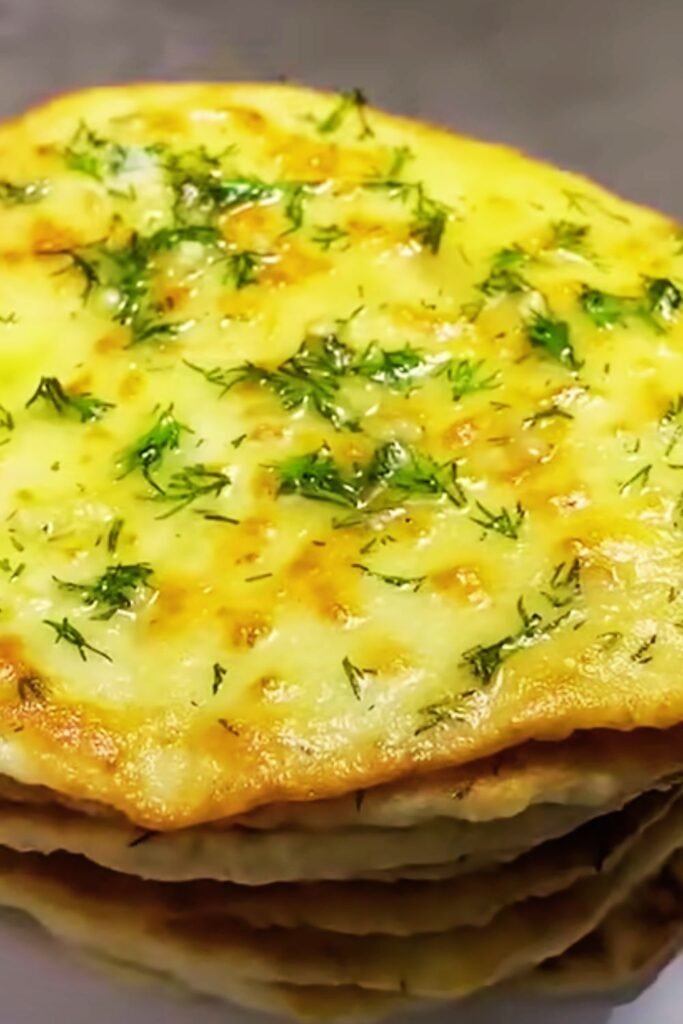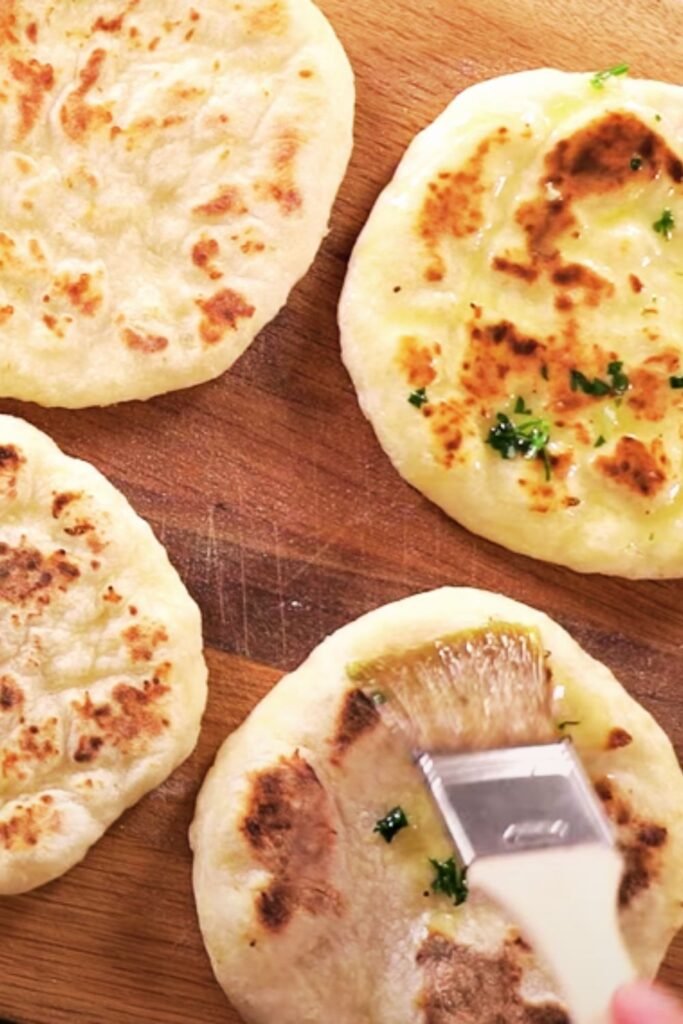Have you ever found yourself craving fresh, warm bread but realized you don’t have yeast on hand? I’ve been there countless times, especially during those spontaneous cooking moments when inspiration strikes. That’s when I discovered the magic of 2-ingredient flatbread – a game-changing recipe that has become my go-to solution for quick, homemade bread without any waiting time for rising or proofing.
This incredibly simple flatbread requires only two basic ingredients that most of us already have in our pantries: self-rising flour and Greek yogurt. No yeast, no waiting, no complicated kneading techniques – just mix, roll, and cook. In less than 30 minutes, you’ll have fresh, soft, and absolutely delicious flatbread that rivals any store-bought version.
What Makes This Flatbread Special
When I first stumbled upon this recipe, I was skeptical. How could something so simple produce such amazing results? The secret lies in the chemical reaction between the self-rising flour and the Greek yogurt. The acid in the yogurt activates the baking powder in the self-rising flour, creating the perfect rise and texture without traditional yeast fermentation.
Key Ingredient Definitions
Self-Rising Flour : A pre-mixed flour blend containing all-purpose flour, baking powder, and salt. The baking powder acts as the leavening agent, eliminating the need for yeast.
Greek Yogurt : Thick, strained yogurt with higher protein content and tangier flavor than regular yogurt. The acidity helps activate the leavening agents while adding moisture and subtle tang to the bread.
Leavening Agent : Any substance that causes dough to rise by producing gas bubbles. In this recipe, baking powder serves as our leavening agent instead of yeast.
The Complete Recipe
Ingredients
| Ingredient | Amount | Purpose | Substitution Options |
|---|---|---|---|
| Self-rising flour | 2 cups | Base and leavening | All-purpose flour + 2 tsp baking powder + 1 tsp salt |
| Greek yogurt (plain) | 1 cup | Moisture and activation | Regular plain yogurt (drained), sour cream |
Equipment Needed
- Large mixing bowl
- Measuring cups
- Clean kitchen towel
- Rolling pin or clean bottle
- Cast iron skillet or heavy-bottomed pan
- Spatula or tongs

Step-by-Step Instructions
- Prepare Your Workspace Start by clearing a clean surface for kneading and rolling. I always dust my counter with a light coating of flour to prevent sticking.
- Mix the Ingredients In a large bowl, combine the self-rising flour and Greek yogurt. Using a wooden spoon or your hands, mix until a shaggy dough forms. Don’t worry if it looks messy at first – this is completely normal.
- Knead the Dough Turn the dough onto your floured surface and knead for 3-4 minutes until it becomes smooth and slightly elastic. The dough should feel soft but not sticky. If it’s too sticky, add flour one tablespoon at a time.
- Rest the Dough Cover the dough with a damp kitchen towel and let it rest for 10 minutes. This brief rest allows the flour to fully hydrate and makes rolling easier.
- Divide and Shape Divide the dough into 6-8 equal portions. Roll each portion into a ball, then flatten with a rolling pin to about 1/4-inch thickness.
- Cook the Flatbread Heat a cast iron skillet or heavy pan over medium heat. Cook each flatbread for 2-3 minutes per side until golden brown spots appear and the bread puffs slightly.
Cooking Time Breakdown
| Step | Time Required | Temperature |
|---|---|---|
| Mixing | 2-3 minutes | Room temperature |
| Kneading | 3-4 minutes | Room temperature |
| Resting | 10 minutes | Room temperature |
| Rolling | 1-2 minutes per piece | Room temperature |
| Cooking | 4-6 minutes per piece | Medium heat |
Nutritional Information
| Nutrient | Per Flatbread (1/6 recipe) | Daily Value % |
|---|---|---|
| Calories | 165 | 8% |
| Protein | 7g | 14% |
| Carbohydrates | 28g | 9% |
| Fiber | 1g | 4% |
| Fat | 3g | 5% |
| Sodium | 380mg | 16% |
| Calcium | 85mg | 8% |
Values are approximate and may vary based on specific ingredient brands

Troubleshooting Common Issues
Throughout my flatbread-making journey, I’ve encountered various challenges that many home bakers face. Here are the most common issues and my tried-and-tested solutions:
Dough Too Sticky
If your dough feels excessively sticky and difficult to handle, gradually add flour one tablespoon at a time. The humidity in your kitchen can affect how much moisture the flour absorbs, so don’t be afraid to adjust.
Dough Too Dry
When the dough appears crumbly and won’t hold together, add Greek yogurt one teaspoon at a time until it comes together. Sometimes different flour brands absorb moisture differently.
Flatbread Won’t Puff
If your flatbread isn’t puffing during cooking, check that your self-rising flour is fresh. Baking powder loses its effectiveness over time, typically after 6-12 months.
Uneven Cooking
For even browning, ensure your pan is properly preheated and maintain consistent medium heat. Too high heat will burn the outside before the inside cooks through.
Flavor Variations and Add-ins
One of the things I love most about this basic recipe is its versatility. Once you master the fundamental technique, you can customize your flatbread in countless ways:
Herb-Infused Variations
- Mediterranean Blend: Add 2 tablespoons dried oregano, basil, and thyme
- Garlic Lover’s: Mix in 3 cloves minced fresh garlic
- Indian-Inspired: Include 1 teaspoon each cumin, coriander, and turmeric
Spice Combinations
- Everything Bagel: Sprinkle with everything bagel seasoning before cooking
- Smoky Paprika: Add 1 teaspoon smoked paprika to the dough
- Black Pepper & Rosemary: Fresh cracked pepper with chopped rosemary
Sweet Variations
- Cinnamon Sugar: Mix cinnamon into dough, brush with butter, and sprinkle sugar after cooking
- Honey Whole Wheat: Replace half the flour with whole wheat and add 2 tablespoons honey

Storage and Reheating
Fresh Storage
Store freshly made flatbread in an airtight container at room temperature for up to 3 days. Layer parchment paper between each piece to prevent sticking.
Freezing Instructions
These flatbreads freeze beautifully for up to 3 months. Wrap individually in plastic wrap, then place in a freezer bag. Thaw at room temperature for 30 minutes before reheating.
Reheating Methods
| Method | Time | Temperature | Best For |
|---|---|---|---|
| Skillet | 1-2 minutes per side | Medium heat | Restoring crispness |
| Oven | 5-7 minutes | 350°F | Multiple pieces |
| Microwave | 20-30 seconds | High power | Quick warming |
| Toaster | 2-3 minutes | Medium setting | Individual servings |
Serving Suggestions
The beauty of this flatbread lies in its versatility. I’ve served it countless ways, and each presentation brings something special to the table:
Breakfast Applications
- Spread with cream cheese and jam for a quick breakfast
- Top with scrambled eggs and fresh herbs
- Use as a base for breakfast pizza with cheese and vegetables
Lunch and Dinner Options
- Serve alongside soups and stews for dipping
- Create wraps with grilled vegetables and hummus
- Use as a pizza base with your favorite toppings
- Pair with Mediterranean dishes like Greek salad and tzatziki
Snack Ideas
- Cut into triangles and serve with various dips
- Brush with olive oil and sprinkle with sea salt
- Create flatbread chips by baking until crispy
Cultural Context and History
While this specific 2-ingredient version is a modern convenience adaptation, flatbreads have ancient roots spanning cultures worldwide. From Indian naan and roti to Middle Eastern pita and Greek pita bread, unleavened and quickly-leavened breads have sustained civilizations for millennia.
The concept of using yogurt in bread-making isn’t new either. Many traditional recipes from the Mediterranean and Middle Eastern regions incorporate dairy products for moisture, flavor, and texture. My version simply streamlines these time-tested principles into a foolproof modern recipe.
Tips for Perfect Results Every Time
After making hundreds of these flatbreads, I’ve developed some insider tips that guarantee success:
Temperature Control
Keep your cooking temperature at medium. High heat will create a tough exterior before the interior fully cooks. Low heat won’t develop the beautiful golden-brown color we’re after.
Thickness Matters
Roll your flatbread to about 1/4-inch thickness. Thinner pieces cook too quickly and become crispy rather than soft and pliable. Thicker pieces may remain doughy in the center.
Don’t Overwork the Dough
Minimal kneading is key. Overworked dough becomes tough and chewy. Just knead until the ingredients come together and the surface smooths out.
Fresh Ingredients Make a Difference
Always check the expiration date on your self-rising flour. The baking powder component loses potency over time, affecting the rise and texture of your flatbread.
Q&A Section
Q: Can I make this flatbread without self-rising flour? A: Absolutely! Mix 2 cups all-purpose flour with 2 teaspoons baking powder and 1 teaspoon salt to create your own self-rising flour substitute.
Q: What if I only have regular yogurt instead of Greek yogurt? A: Regular yogurt works, but drain it first by placing it in a fine-mesh strainer lined with cheesecloth for 30 minutes to remove excess whey.
Q: How do I know when the flatbread is fully cooked? A: Look for golden-brown spots on both sides and a slight puffing. The flatbread should sound hollow when tapped and feel firm but not hard.
Q: Can I make the dough ahead of time? A: Yes, but use it within 2 hours. The baking powder begins working immediately when mixed with the yogurt, so extended waiting reduces the rise.
Q: Why is my flatbread tough instead of soft? A: This usually happens from overworking the dough or cooking at too high heat. Keep kneading minimal and maintain medium cooking temperature.
Q: Can I double or triple this recipe? A: Certainly! The recipe scales perfectly. Just maintain the 2:1 ratio of flour to yogurt by volume.
Q: Is there a gluten-free version? A: Yes, substitute the self-rising flour with a gluten-free self-rising flour blend. The texture will be slightly different but still delicious.
Q: How long does the dough keep in the refrigerator? A: I recommend using it immediately for best results, but it can be refrigerated for up to 24 hours. Let it come to room temperature before rolling and cooking.
Q: Can I cook these on a grill instead of stovetop? A: Absolutely! Preheat your grill to medium heat and cook for 2-3 minutes per side. This adds a wonderful smoky flavor.
Q: What’s the best way to keep them warm while cooking multiple pieces? A: Wrap cooked flatbreads in a clean kitchen towel or keep them in a 200°F oven until ready to serve.
This 2-ingredient flatbread has revolutionized my approach to homemade bread. It’s proof that sometimes the simplest recipes yield the most satisfying results. Whether you’re a beginner baker or someone looking for a quick bread solution, this recipe delivers consistent, delicious results every single time. The next time you’re craving fresh bread but don’t want to deal with yeast and rising times, remember this simple combination of self-rising flour and Greek yogurt – it’s truly magical.